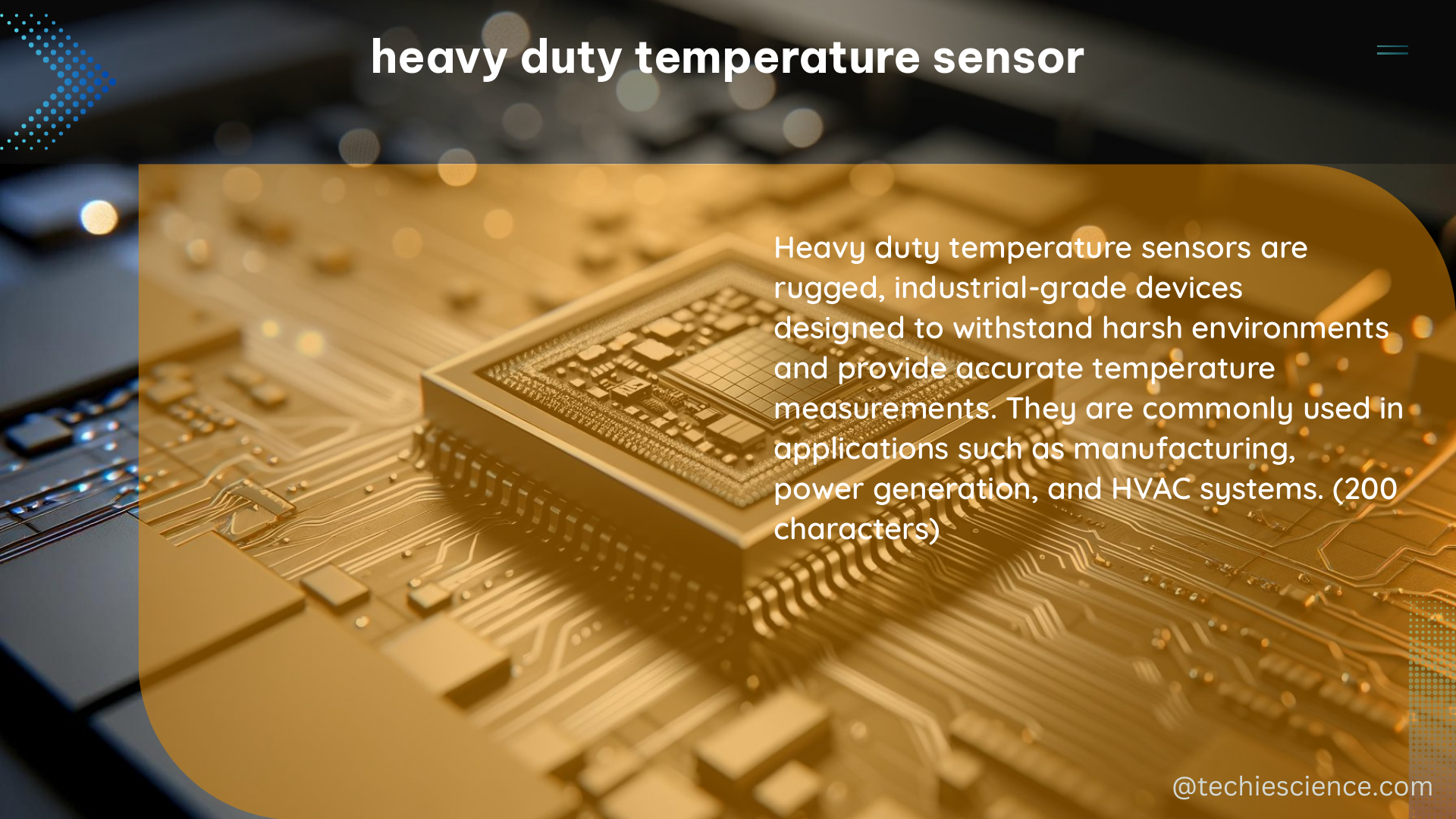Heavy-duty temperature sensors are crucial in various industrial applications, such as power generation, manufacturing, and chemical processing, where precise temperature measurements are required. These sensors are designed to withstand harsh environmental conditions, including high temperatures, vibrations, and corrosive environments, while providing accurate and reliable temperature readings.
Technical Specifications of Heavy-Duty Temperature Sensors
Temperature Range
Heavy-duty temperature sensors can measure temperatures ranging from -200°C to 2000°C, depending on the sensor type. For example, thermocouples can typically measure temperatures up to 1800°C, while resistance temperature detectors (RTDs) can measure temperatures up to 850°C.
Accuracy
The accuracy of heavy-duty temperature sensors depends on the sensor type and the temperature range. Thermocouples have an accuracy of ±2.2°C or ±0.75%, whichever is greater, while RTDs have an accuracy of ±0.1°C or ±0.15% of the reading, whichever is greater.
Response Time
The response time of heavy-duty temperature sensors varies depending on the sensor type and size. Thermocouples have a response time of less than 1 second, while RTDs have a response time of a few seconds to several minutes, depending on the sensor size and construction.
Output Signal
Heavy-duty temperature sensors can provide an analog or digital output signal. Analog signals include 4-20 mA, 0-10 V, and 0-5 V, while digital signals include RS-232, RS-485, and Modbus. The choice of output signal depends on the application requirements and the type of data acquisition or control system used.
Environmental Factors
Heavy-duty temperature sensors are designed to withstand harsh environmental conditions, including high temperatures, vibrations, and corrosive environments. They are typically made of stainless steel or other durable materials and are designed to be waterproof and dustproof, with IP ratings ranging from IP65 to IP68.
Power Supply
Heavy-duty temperature sensors can operate on a wide range of power supplies, including AC and DC voltages. The power supply voltage varies depending on the sensor type and the manufacturer, with common voltages ranging from 12 VDC to 240 VAC.
DIY Guide for Heavy-Duty Temperature Sensors

Building a heavy-duty temperature sensor requires knowledge of electronics and programming. Here is a step-by-step guide to building a heavy-duty temperature sensor:
Select a Temperature Sensor
Choose a temperature sensor that meets your requirements in terms of temperature range, accuracy, and response time. Some popular temperature sensors for DIY projects include the DS18B20, LM35, and TMP36. Consider factors such as the sensor’s operating temperature range, accuracy, and compatibility with your microcontroller.
Connect the Temperature Sensor to a Microcontroller
Connect the temperature sensor to a microcontroller, such as an Arduino or Raspberry Pi. This will allow you to read the temperature data from the sensor and send it to a computer or display it on an LCD screen. Ensure that the sensor’s output signal is compatible with the microcontroller’s input requirements.
Power Supply
Power the temperature sensor and microcontroller using a suitable power supply. This can be a battery, a DC power supply, or a USB cable. Choose a power supply that can provide the necessary voltage and current to the sensor and microcontroller.
Programming
Write a program to read the temperature data from the sensor and display it on the LCD screen or send it to a computer. You can use a programming language such as C, Python, or Java to write the program. Consider implementing features such as temperature scaling, data logging, and alarm functions.
Testing and Calibration
Test the temperature sensor in different environmental conditions to ensure it provides accurate temperature readings. You can also calibrate the sensor using a reference temperature source to improve its accuracy. Perform thorough testing to ensure the sensor’s reliability and performance under various operating conditions.
By following this DIY guide, you can build a heavy-duty temperature sensor that meets your specific requirements and can be used in a variety of industrial applications.
References:
– Lake Shore Cryotronics, Inc. (2014). Appendix E: Temperature Measurement System. Retrieved from https://www.lakeshore.com/docs/default-source/temperature-catalog/lstc_appendixe_l.pdf?sfvrsn=b5177ae1_8
– Woolf, R. (2023). Chemical Process Dynamics and Controls. Retrieved from https://eng.libretexts.org/Bookshelves/Industrial_and_Systems_Engineering/Chemical_Process_Dynamics_and_Controls_%28Woolf%29/03:_Sensors_and_Actuators/3.02:_Temperature_Sensors
– The Cave Pearl Project (2016). Triage Step for Cheap DS18b20 Temperature Sensors. Retrieved from https://thecavepearlproject.org/2016/02/12/triage-step-for-cheap-ds18b20-temperature-sensors/.

The lambdageeks.com Core SME Team is a group of experienced subject matter experts from diverse scientific and technical fields including Physics, Chemistry, Technology,Electronics & Electrical Engineering, Automotive, Mechanical Engineering. Our team collaborates to create high-quality, well-researched articles on a wide range of science and technology topics for the lambdageeks.com website.
All Our Senior SME are having more than 7 Years of experience in the respective fields . They are either Working Industry Professionals or assocaited With different Universities. Refer Our Authors Page to get to know About our Core SMEs.